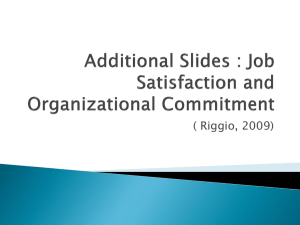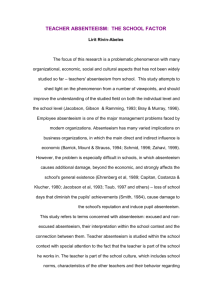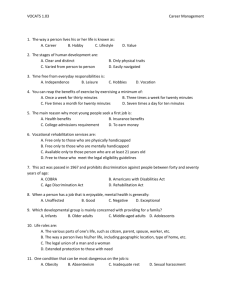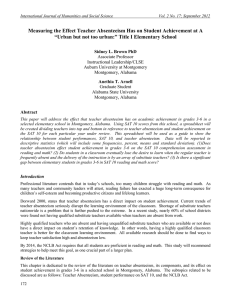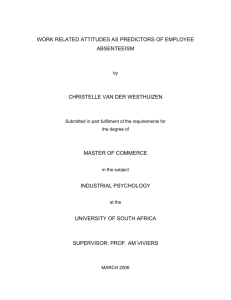How to Solve Your Employee Absentee Problem
advertisement
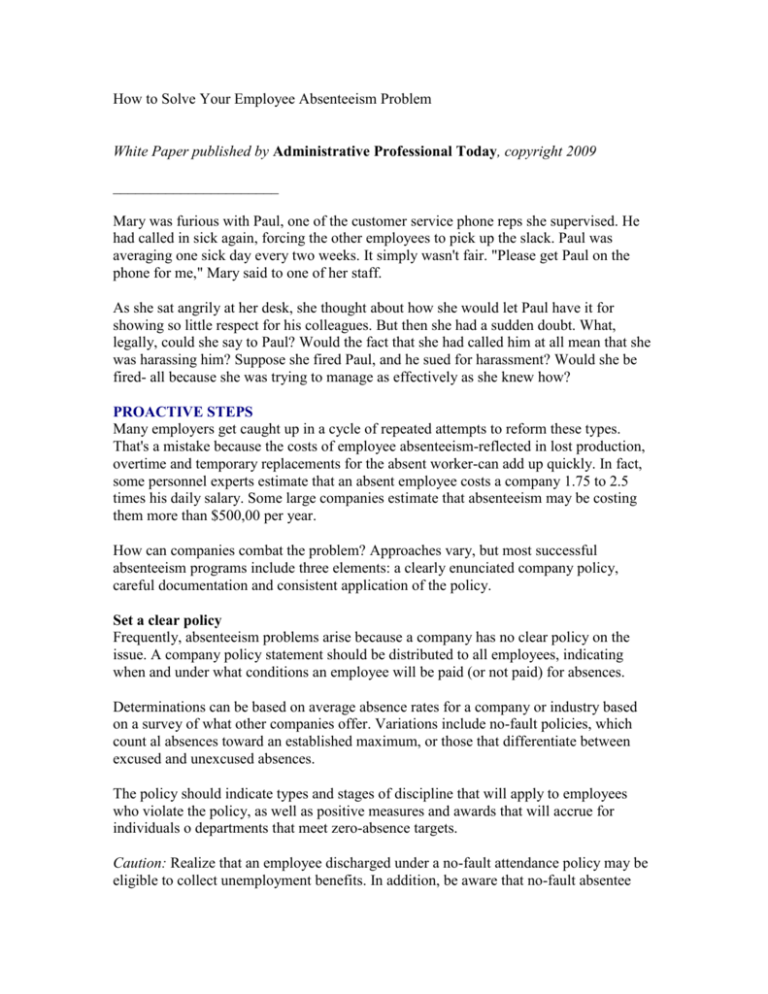
How to Solve Your Employee Absenteeism Problem White Paper published by Administrative Professional Today, copyright 2009 ______________________ Mary was furious with Paul, one of the customer service phone reps she supervised. He had called in sick again, forcing the other employees to pick up the slack. Paul was averaging one sick day every two weeks. It simply wasn't fair. "Please get Paul on the phone for me," Mary said to one of her staff. As she sat angrily at her desk, she thought about how she would let Paul have it for showing so little respect for his colleagues. But then she had a sudden doubt. What, legally, could she say to Paul? Would the fact that she had called him at all mean that she was harassing him? Suppose she fired Paul, and he sued for harassment? Would she be fired- all because she was trying to manage as effectively as she knew how? PROACTIVE STEPS Many employers get caught up in a cycle of repeated attempts to reform these types. That's a mistake because the costs of employee absenteeism-reflected in lost production, overtime and temporary replacements for the absent worker-can add up quickly. In fact, some personnel experts estimate that an absent employee costs a company 1.75 to 2.5 times his daily salary. Some large companies estimate that absenteeism may be costing them more than $500,00 per year. How can companies combat the problem? Approaches vary, but most successful absenteeism programs include three elements: a clearly enunciated company policy, careful documentation and consistent application of the policy. Set a clear policy Frequently, absenteeism problems arise because a company has no clear policy on the issue. A company policy statement should be distributed to all employees, indicating when and under what conditions an employee will be paid (or not paid) for absences. Determinations can be based on average absence rates for a company or industry based on a survey of what other companies offer. Variations include no-fault policies, which count al absences toward an established maximum, or those that differentiate between excused and unexcused absences. The policy should indicate types and stages of discipline that will apply to employees who violate the policy, as well as positive measures and awards that will accrue for individuals o departments that meet zero-absence targets. Caution: Realize that an employee discharged under a no-fault attendance policy may be eligible to collect unemployment benefits. In addition, be aware that no-fault absentee policies could violate the Americans with Disabilities Act (ADA) and the Family and Medical Leave Act (FMLA). Some courts have found that an employer might have to reasonably accommodate an employee's qualified disability under the ADA regardless of its no-fault absentee policy. Also, you cannot count FMLA leave time in determining whether a threshold number of absences has been reached under a no-fault policy. Always document absences Documentation is a cardinal rule in any activity for which an employee may be disciplined. You should keep attendance/absence records for all employees. An absence rate can be figured by dividing the number of days an employee was scheduled to work for a given period into the number of absences. You can also calculate average absence rates for each department and for the company as a whole. Be consistent No company policy is going to remain effective unless it is applied consistently and fairly to all employees. For this reason, supervisory personnel should be clear on their responsibilities for recording data and for counseling and disciplining employees. Yet, an absenteeism policy must also remain flexible enough to allow for special problems and situations that might arise. (Lack of flexibility is one of the reasons most often given by professional arbitrators for overruling company disciplinary actions arising from employee absenteeism.) Observation: Perhaps the most important point a company can make concerning employee absenteeism is that a sick leave or absence policy is not a benefit to be equated with vacation time or personal leave. The more employees understand this and recognize your commitment to disciplining chronic absenteeism, the fewer problems you are likely to have. USE POSITIVE DISCIPLINE When you're faced with an employee who is chronically absent, it's best to have a positive discipline program in effect. For example, assume that a worker has an absenteeism problem resulting in lower productivity. Because absenteeism typically comes under the "minor problem" category, the first step is a precounseling session between the individual and his supervisor. In this session the supervisor determines if the employee understands the company's policy on absences. The positive discipline approach then consists of the following stages: Oral reminder stage. This stage follows the counseling session and lasts three months or however long seems to be in the company's best interest. But the period has to be uniform for all employees. If you resolve the problem, the slate is wiped clean and so is the documentation of the incident. Written reminder stage. If the problem still exists after the counseling session, a second counseling session between the employee and his supervisor is scheduled. This time, however, the supervisor writes a memo to the individual spelling out the problem, the worker's acknowledgment of it and his agreement to work toward its resolution. A copy is placed in the employee's personnel file. The written reminder stage lasts six months, or however long you think is best for the company. If the problem is resolved within this time, the memo is considered inactive and there are no repercussions for the worker. However, don't discard the memo-keep it in the employee's personnel file. Decision-making stage. If the absenteeism problem still exists after the written reminder stage, the supervisor has a final meeting with the employee, during which he spells out the company's policies again. Then the employee is given a one-day leave of absence to decide if he wants to continue working for the company on the condition that he agrees to abide by its rules. An issue related to absenteeism is whether you can legally terminate an employee who routinely has to take time off because of his service obligations to the Reserve or National Guard. Generally speaking, workers have an absolute right to the time off because of their service obligations-even if it is inconvenient for you-and a job has to be waiting for them when they return. But it doesn't have to be the same job, just one with the same status, pay and benefits as the previous one. So be sure that you can objectively show that the new job is of equal status. Caution: Federal law and many state laws protect Reservists and members of the National Guard from discrimination on the basis of their service obligations. You cannot target an employee for dismissal in a downsizing because he routinely has to go to training camp during your busiest season. Another related issue is whether an employee's excessive absenteeism is the result of a serious health condition. If so, or if you are not sure, be aware that you may have legal obligations under the FMLA or the ADA. HOW TO ASSESS THE IMPACT OF ABSENTEEISM A few specific questions will help you take a realistic measure of losses: Has work remained undone because people were out? Have department work schedules been disrupted? Have completion deadlines or shipping schedules been missed because absentees slowed down the work? Has your personal work schedule been knocked awry because you had to juggle assignments? Find replacements? Do on-the-spot training for fill-in employees? Have departmental costs risen because absenteeism has led to work being spoiled by replacements failing to perform as well as the regulars? Lower productivity? Overtime work? A Suprvisor's Guide to Reducing Absenteeism: 5 Strategies Say your company has an absenteeism policy in place, but you're still experiencing a high rate of absenteeism. It may be a good idea to get your managers and supervisors together to plan a strategy. Here's what others have done in similar situations: 1. Provide outlets for dissent. Not all absenteeism is capricious. When people are denied outlets for their job pressures, they tend to run from them. Managers or supervisors who don't tolerate complaints force employees to bottle up pressures, which build up over time. If you make dissent possible by encouraging people to speak up, hearing them out and, where feasible, acting on what you hear, they learn that they don't have to escape from the workplace to let off steam. 2. Cut the drag of boring work. You can't eliminate boring work. But you can try to reduce a person's need to flee from it. Here are two suggestions to consider: * Expand boring jobs so that employees can see their tasks through to a worthwhile result. Giving work a beginning, a middle and an end increases at least threefold the satisfaction to be gained from it. * Break down boring jobs into smaller pieces so that a variety of tasks can be distributed among more people. Diversifying each person's job makes the work a little more interesting and a little less boring and time-consuming. 3. Use incentives. Extra pay for showing up is not a radical idea, and it's relatively cheap. The concept of "well pay" instead of sick pay has proved itself and can be easily adopted. For example, for each authorized (paid) sick day people do not use by year's end, they get paid for a day and a half. Or let employees bank sick time to be used against a future disability. These kinds of arrangements can be a magnet to the workplace. 4. Try gimmicks. They're only good for the short term, but they're also reusable from time to time. Try a departmental contest. For example, the person with the lowest number of absences in a three-month period wins a gift card. Use gimmicks sparingly, but play them up when you do. And make them fun, not work: Don't ask people to do anything except come to work on time. 5. Explain how absenteeism affects everyone. When people feel easily replaceable, they think they won't be missed. If you tell them why they're needed, they won't want to stay away. Each employee is in some way a specialist; taking the time to point this out makes each one feel skilled, valued and needed.



